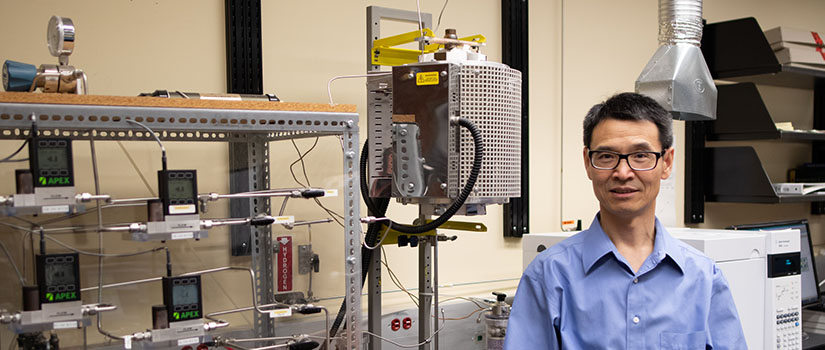Ethylene is the essential building block to make resins and plastics. Approximately 200 million tons are produced annually, and its worldwide production exceeds any other organic compound.
The conventional method of producing ethylene is steam cracking of ethane in a chemical plant by using extreme temperatures and pressures. This requires a large energy input and releasing substantial amounts of carbon dioxide, a greenhouse gas. Mechanical Engineering professors Fanglin (Frank) Chen and Kevin Huang are in the early stages of research to develop an alternative, efficient and environmentally benign ethylene with negative carbon dioxide emissions.
“Ethylene is the most important chemical in the petrochemical industry. The conventional process to produce ethylene is energy intensive and a heavy emitter of carbon dioxide, a greenhouse gas. Consequently, alternative conversion technologies are critically needed for efficiency improvements in chemical manufacturing while combating the global warming,” Chen says.
This past June, Chen received a three-year, $2 million grant sponsored by the U.S. Department of Energy’s (DOE) Office of Energy Efficiency and Renewable Energy (EERE), under the Advanced Manufacturing Office (AMO). Their mission is to investigate new manufacturing technologies, including chemical manufacturing due to its significant energy usage and emissions.
Ethylene has historically been made from petroleum, but the production has been transitioning to using natural gas. The principal method of producing ethylene is steam cracking, a process which breaks down hydrocarbons through the refining of petroleum or natural gas.
“The steam is produced and fed by natural gas. The cracking process takes place at 800 to 900 degrees Celsius,” Chen says. “The process is expensive because at that high temperature you have steam in a harsh environment, and the reactors must hold that temperature.”
According to Chen, the process produces substantial amounts of carbon dioxide because as water is generated into steam, a significant amount of natural gas is burned. The energy intensive process consumes high rates of energy and produces a significant amount of carbon dioxide emissions.
Chen’s research aims to develop an unprecedented carbon dioxide-natural gas refinery technology, enabling an electrochemical conversion of low-cost natural gas into valuable ethylene with co-production of carbon monoxide through a simultaneous conversion of carbon dioxide. The technology is built upon a unique symmetric metal-supported solid oxide cell technology, which may forge a new process-intensified path towards an efficient, low-emission and modular chemical manufacturing process. Using renewable electricity to integrate low-cost natural gas and carbon dioxide while converting methane to valuable chemicals will revolutionize the chemical manufacturing industry.
The biggest difference compared to the traditional method is how the University of South Carolina team plans to have two reactions instead of one. As in the traditional method, one reaction will convert natural gas to ethylene. But the second reaction will remove one oxide ion from carbon dioxide to create carbon monoxide, an important chemical used to manufacture numerous organic and inorganic chemical products, pharmaceuticals, semiconductors, steel and metals.
The oxide ion removed from carbon dioxide will be used in the natural gas reaction to break the carbon-hydrogen bond and combine with hydrogen to make water. As a result, the carbon atoms simply connect to generate ethylene.
“Carbon dioxide is a greenhouse gas, but we can use it to create a useful chemical in carbon monoxide. Natural gases are valuable chemicals but not as important compared to ethylene,” Chen says. “We can convert natural gas to ethylene, and carbon dioxide to carbon monoxide to make value-added chemicals.”
Chen aims to keep the reaction temperature to around 650 degrees Celsius, which is cooler than the traditional method. A lower temperature leads to less maintenance and heat released into the environment to save energy.
“The endothermic reaction of using carbon dioxide to produce carbon monoxide will absorb heat from the other reaction that converts natural gas to produce ethylene. Since heat is produced from one side and absorbed and utilized from the other side, it’s balanced, and the process is efficient and less damaging to the environment,” Chen says.
The team will initially use a smaller reactor for process optimization, but the process is capable of scaling up to create a larger reactor for more ethylene production.
“The conventional process typically operates as a large chemical plant. It needs a big vessel because the process cannot be optimized with a smaller one,” Chen says. “Our process is better because regardless of the size, it’s the same efficiency. There are no limitations compared to the conventional process; it does not need a high pressure, and it’s more flexible.”
Chen is excited to tackle these challenging issues and believes the new process will help the chemical industry cut emissions and enter a new era of sustainable manufacturing. “The chemicals industry is the largest consumer of energy and major carbon emitter nationally. There is abundant supply of domestic natural gas which will fuel the return of the chemical industry to the U.S. The low cost of renewable electricity in the U.S. provides impetus for process electrification. The electrochemical method, if successful, will revolutionize the chemical manufacturing industry.”
